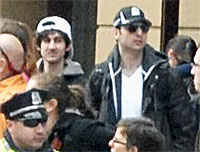More About Tsarnaev Brothers And Their Ancestral Homeland

(RFE/RL – rferl.org – April 19, 2013) Two ethnic Chechens, Tamerlan and Dzhokhar Tsarnaev, are suspected of having perpetrated the Boston Marathon bombings on April 15 that killed three people and injured 170 others. As information accumulated — and confusion swirled — about them, RFE/RL Central Newsroom Director Jeremy Bransten sat down with Aslan Doukaev, director of RFE/RL’s North Caucasus Service, for some insight into those two brothers and their ancestral homeland.
RFE/RL: What do we know about the Tsarnaev brothers before they came to the United States? They are ethnic Chechens but didn’t grow up in their ancestral homeland, correct?
Aslan Doukaev: What we know exactly is that these two young men…at a young age, their family moved to Daghestan, a Russian republic in the North Caucasus*. They attended school there, probably for a year or two and, later on, these two young men moved to the United States of America to continue their education there. That’s what we know for certain.
RFE/RL: Hundreds of thousands Chechens were forcefully resettled in Central Asia and other parts of the then-Soviet Union under former Soviet leader Josef Stalin. Can you give us a brief historical overview of how the Chechens ended up ended up in places like Kyrgyzstan and Kazakhstan?
Doukaev: Yes, that’s a story in itself. That was a decision by the Soviet government at the end of the second World War, in 1944, to deport the entire Chechen and Ingush nations to Central Asia and Siberia. A lot of these people were moved to Kyrgyzstan — Kirghizia in those days. They spent 13 years as exiles in Kazakhstan and Kyrgyzstan. Later, [Nikita] Khrushchev, the new leader of the Soviet Union, rescinded that decision and allowed Chechens and Ingush to return to their homelands. But a lot of families decided to stay in Kyrgyzstan, Kazakhstan, and other places for various reasons, mostly economic, and simply because they had no families or relatives waiting for them in Chechnya-Ingushetia. So that’s the tragic history, a tragic page from Chechnya’s recent history, which in many ways still affects the mentality and the thinking of a lot of Chechens.
RFE/RL: You mentioned earlier that in transit to the United States, the Tsarnaevs spent some time in Daghestan, although they were ethnic Chechens. Daghestan has recently become the focus of much of the violence in the North Caucasus. Can you give us a picture of what has been happening in that republic over the past 15-20 years?
Doukaev: It all began in 1994, when the so-called first Chechen War began in neighboring Chechnya. Chechnya over the past 19 years has suffered two serious conflicts. It left behind devastation and destruction and a lot of people were killed. But that conflict was not contained to Chechnya only. It gradually spread to neighboring territories: Ingushetia, Kabardino-Balkaria, and in particular, to Daghestan.
Daghestan is the biggest Russian republic in the North Caucasus. It’s the size of Scotland, it’s multiethnic and it has become these days the epicenter of instability in the south of Russia. While Chechnya is increasingly peaceful and stable — more or less — Daghestan seems to be descending into chaos. Every day we get reports about clashes, attacks, bombings, kidnappings. So Daghestan has a become a focal point of the insurgency in the North Caucasus.
RFE/RL: And is it fair to say that the mood in society has become increasingly radicalized?
Doukaev: We can say with certainty that Daghestan today is probably the most radicalized Russian republic. The so-called Salafis, the Wahhabis, they openly organize their meetings. The insurgency enjoys a certain amount of support from the population. There are various reasons why that’s happening. We may talk a lot about the corruption, the economic situation, the police brutality etc…. The fact is that today Daghestan is the most unstable, the most violent, the most radicalized territory in the whole of the Russian Federation.
RFE/RL: Now of course these two young men were living in the United States, though it seems their families retained strong links to the North Caucasus. What do we know about the North Caucasus diaspora in the United States? Are ethnic Chechens the most numerous?
Doukaev: We don’t know much about the diaspora. It’s not very big. There were several waves of immigration. The first wave was after World War II, and this diaspora lives in New Jersey, mostly. I hear that there are small communities in various parts of the United States, in Portland, Oregon, in Boston — by the way. But by and large, the Chechen community in the United States is very small and it’s not really well organized. There are scattered communities in various parts of the States. I don’t think they were in any way part of those communities, part of those diasporas. They had a kind of isolated existence in Massachusetts, mostly.
* CORRECTION: The interviewee initially quoted reports — including from RFE/RL’s Kyrgyz Service, quoting an Interior Ministry source — suggesting that both Tsarnaev brothers were born in Kyrgyzstan. That information subsequently proved incorrect. Twenty-six-year-old Tamerlan Tsarnaev was born in Kyrgyzstan, near the border with Kazakhstan, and the surviving 19-year-old Dzhokhar Tsarnaev was born in the southern Russian republic of Daghestan, according to a relative interviewed by RFE/RL’s Kyrgyz Service.
Article copyright (c) 2013. RFE/RL, Inc. Reprinted with the permission of Radio Free Europe/Radio Liberty, 1201 Connecticut Ave., N.W. Washington DC 20036.
RFE/RL – rferl.org – article also appeared at: http://www.rferl.org/content/tsarnaev-boston-suspects-chechen-profile-homeland-interview/24963053.html
